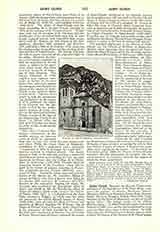

Saint Cloud, Diocese of (SANCTI CLODOALDI), suffragan of the Archdiocese of St. Paul, Minn., comprises the counties of Stearns, Sherburne, Benton, Morrison, Mille Lacs, Kanabec, Grant, Pope, Stevens, Isanti, Traverse, Douglas, Wilkin, Otter-Tail, Todd, Wadena, in the State of Minnesota, an area of 12,251 square miles. The bishop resides in St. Cloud, Stearns county. In 1680 Father Hennepin visited the Indians at Mille Lacs, and for one hundred and seventy years no other priest came to these regions. In 1851, when this part of Minnesota was thrown open to white settlers, the history of the Diocese of St. Cloud begins. In 1852 Rev. Francis Pierz (Pirc), a native of Carniola, Austria, came from his former Indian missions at Lake Superior to Minnesota to labor among the Chippewa Indians. Finding the country well adapted to agriculture, he announced the fact in some Catholic German papers, and thus caused a large immigration of German Catholics, especially to Stearns county. In 1856 Bishop Cretin of St. Paul sent three Benedictines, Fathers Demetrius de Marogna, Cornelius Wittmann, and Bruno Riss, to attend the ever-increasing numbers of settlers. They settled on a piece of land near the present city of St. Cloud, where they built a small log house and chapel. In 1857 they erected a college, and opened a school with five pupils. A change of location, however, was desirable, hence land was secured around St. John’s Lake, and in 1866 a college and monastery were permanently established. They have now flourishing parishes and a university with more than three hundred students. The first abbot, Rt. Rev. Rupert Seidenbusch, was made Vicar Apostolic of Northern Minnesota (1875). He resided in St. Cloud until 1888 when, on account of poor health, he resigned. He built the present pro-cathedral and died June 3, 1895. The present Diocese of St. Cloud was created in 1889 with Rt. Rev. Dr. Otto Zardetti as its first bishop. Dr. Zardetti, a native of Switzerland, was born January 24, 1846. He was ordained priest August 21, 1870, and in 1881 became professor of dogma in the St. Francis Seminary, near Milwaukee. In 1886 he was made vicar-general of Bishop Marty of Yankton. As Bishop of St. Cloud, he was extremely active, and renowned as a pulpit orator. In February, 1894, he was made Archbishop of Bucharest in Rumania and died at Rome May 9, 1902. When he took charge of the Diocese of St. Cloud, he found about 30,000 souls in the charge of 69 priests, 52 religious and 17 diocesan. When he resigned, there were about 40,000 souls in the charge of 33 secular priests and 16 religious, besides 19 religious in the monastery. His successor was Rt. Rev. Martin Marty, O.S.B., also a native of Switzerland. In 1879 he was appointed Vicar Apostolic of Dakota, residing in Yankton, in 1889 first Bishop of Sioux Falls, South Dakota, and December 31, 1894, was transferred to St. Cloud. He took charge of the new see March 12, 1895, but died September 19, 1896. Rt. Rev. Msgr. Jos. Bauer was administrator of the diocese until September 28, 1897, when the present bishop, James Trobec, arrived as third bishop of the diocese. There are about 62,000 souls; 125 priests, 78 secular and 47 religious; 115 churches and 12 chapels; 1 university; 2 academies; 4 hospitals; 1 home for old people; 1 orphan asylum; parochial schools wherever possible. The religious communities represented in the diocese are the Benedictines and the Holy Cross Fathers; the Benedictine Sisters, who number about 400 and have charge of parochial schools, a hospital, and a home for the aged; the Sisters of St. Francis, who have charge of an orphan asylum and three hospitals; the Sisters of St. Mary of the Presentation.
JAMES TROBEC

